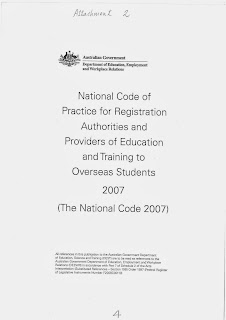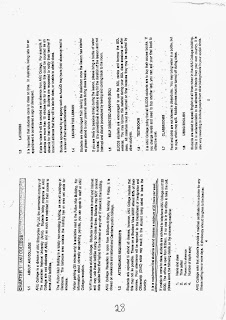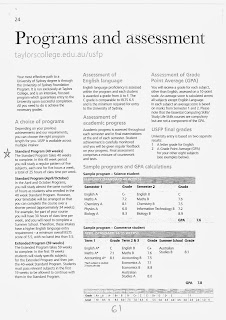重要聲明
本人於2009年2至9月期間在澳洲ANU College修讀之兩學期大學基礎班存在多方缺失, (一)課程內容與課程冊子所述不符、(二)每節課時嚴重不足、(三)延伸單一學期及單一科目之教學週期有違公平機制、(四)有科目之課程管理不當。種種因素下, 同學不但蒙受金錢損失, 對學業上之負面影響更是難以彌補。本人曾投訴於課程監管局(ACT Accreditation
& Registration Council Secretariat)並隨後訴諸法庭(Federal
Magistrate Court), 無奈判決皆令人遺憾。証據顯示校方欠缺課時之情況及至2011年六月學期完結, 從同窗得悉校方從未就其之失當行為向受影響學生交待或賠償, 故呼籲同學詳閱內容, 挺身為公義與既得利益討回公道。Overseas
Students Ombudsman有這樣之承諾“Publishes reports on problems and broader issues
in international education that we identify through investigations” “ Ask default education provider to provide
refund for students”. 主動聯絡可確認身份之失物主人倒是警方恆常之責, 歡迎教育及法律學者秉持公義審視個案。
在學期間, National Code
2007是用以保障負笈全澳洲海外生之法規, 其前身National Code 2001 13.2列明全日制課程每週上課時數及課程週期不可少於20小時及36週(1), National Code 2007放寬了學生必須於每學期接受不少於20小時之課堂, 惟學生仍需在原定時間完成整個課程(2), 此例載明是基於個別學生自身之非常環境,如須調節學習進度, 故校方仍需為每一學期定立法制下之恆常每週上課時數以配合課程週期。"RMIT
2009之課程冊子註有大學基礎班與VCE 12班之課程相類並受全國大學認可(3), 調查得知, 各省12班之上課週期繫於Standard Australian Academic Calendar 並定為約40週。 Foundation Program Standard 草擬於2010年初並於年中刊登,當中Standard 7 之條文規定標準大學基礎班之教學週期需不少於26週及不超於40週, 而總課堂時間不可少於720小時(4), 這無疑與前述"National
Code 2001"所定課程之總課堂時間不可少於720小時相符。從邏輯分柝, 澳洲學制沿用巳久, 豈有理據支持整個課程之總課時於上文提及時期獲得縮減。
商榷之處列出如下:
(一)按校方2008/2009課程冊子訂明每學期修讀四個科目,即共八個科目(5), National Code 2007 Part D 2.1b 指出課程內容、課程週期、獲頒學歷及評核方法需於學位接納信發出前給予上述資料(6)。在開課時校方自行加插電腦科於本人首學期‚此不可抗修之例已違反上述法規‚因課程冊子巳定明此科為自選科目‚校方附予法庭之2009課程冊子亦無說明此為必修科‚奈何監管局以轉介Overseas Students
Ombudsman(OSO)繼續跟進為由‚不作調查‚"OSO"於兩個月後以各項指控不能完全確証, 逐終止調查。遺憾法官竟引用課程冊子列出可作修改之括免條例為裁決理據。
(二)本人於2010年9月13日以書面向監管局投訴校方各項失當(7)‚附件有上課時間表(由校方派予並可覽閲此學期之所有科目及不同班別每星期之上課時間)(8)、兩學期之學業成績表等(9)....... 10月5日收到局方電郵通知上述投訴信及附件收妥(10)‚10月18日本人以電郵強調課時不足並列舉負面影響之實例(11)‚翌年1月14日局方只確認校方需提供每週不少於20小時之課堂時間‚但沒扼要說明校方應提供每週實際課時
(本人曾於1月6日再提及校方沒有提供足夠課時並列出相關課程上課日子(12)。按28週之教學週期‚以總課時不可少於720小時計算‚校方應提供每週不少於25小時之課堂時間‚手冊亦列明每週上課不可少於20小時(13), (因學生享有不多於20%之法定缺席率,故校方需提供每週不少於25小時之課堂時間)本人於2011年3月竟獲局方通知校方未有觸犯National Code 2007之相關規條‚校方2010/2011課程冊子載有由2010年10月至2011年6月‚每學期之教學週期仍為14週(14)‚(與2008年2月至2010年10月無異)‚本人曾於2010年12月到訪當地參予調解會‚特路經校舍獲一位同學給予其時之時間表(15)‚此學期任何四科每週總課時只有17.5小時‚與本人修讀此課程無甚分別‚(只會計一科之課時有別)‚校方與監管局於2011年3月就有關投訴之會議紀錄(16))顯示本人第一及第二學期每週總課時分別為19.5及20.5小時‚這可是包括第一及第二學期額外修讀之電腦及重修學術英語‚重修學術英語是因此科分數低於入讀附屬大學2%之要求‚這是在課時不足及額外加顧一科下促成。修畢進階學術英語而在修讀第三學期之學生,
每週總課時則只有14小時吧。
(三)National Code 2007條文規定學生修讀期不可超於此課程於CRICOS註冊時所定之課程週期(17)‚CRICOS CODE 52133A是在學時兩學期課程之唯一註冊‚學校自行延長單一學期單一科目六週以為原於十月畢業之同學符合簽證要求‚(學生不可停學多於三個月) 由10月至11月底每週只需上課兩節共3.5小時延續修讀一科‚(與全日制定義背馳) 促成這群學生享有極充裕之備課時間‚其他學期畢業之同學只可於緊湊之14週內同樣完成四個科目‚此延伸週期之科目是不設考試於其他科目九月底之終考週內‚而部份測驗,功課和終考將繫於10月至11月間(18)‚在完成課程後任何同學仍可以其成績報讀其他大學‚包括海外大學, 這偏頗之週期設計‚無疑可將利潤推至高點。上文提及之會議紀錄載有局方需就此項投訴作出跟進‚但與會及閱文件後(不明文件) 局方會通知本人此課程乎合有關法例要求‚惟局方官員兩次提及就有關事項本人可提出上訴‚而校方可要作出修改。本人不時參看 National Code 2007相關條文(至今未有條文或輔例許可在此情況下延長教學週期)。遺憾有關疏忽指控亦未能得值。調查六所相關標準課程營辦者之入學門檻、課程週期及每小時學費‚校方之入學門檻不但與眾相若‚還較部份營辦者為低(19)。校方直系大學ANU被評為澳洲排名第一之大學並在全球最佳大學中排名前列, 故校方兩學期相關課程之週期及週時較其他營辦者大幅偏低豈有自圓之理? 從2008-2010年, ANUC相關課程之學費(以小時計算)大幅高於一眾營辦者, 與雪梨大學同期於2010年10月開課之學期比較,其每小時之學費高了34%, 與西澳洲大學同期於2008年開課之學期比較, 其每小時之學費高了不少於25.6% (載於www.takonyee.blogspot.com) 。
(四)遺憾法官在未有反駁下判決第二學期修讀之“Communication Studies”不構成疏忽之指控, 證據顯示此科課程大綱不是由首任老師派發,大綱於第五週派發而首頁印有第三週才接任老師之名字及電郵地址(20), 時間表上可見此科在我班列有首任老師之簡稱,另課本課題次序與大綱課題次序不符增添備課障礙(21),大綱派發前老師未提及習作題目, 學期所有習作題目見於大綱而首份習作列於第七週完成, 其他科目之中期考試均設於此週, 老師每星期給予需於下一堂提交而需評分之家課而別班沒有此安排有違National Code
2007 Part D 2.1b 一致評核方法之要求, 本人無法在極緊迫之時間如期提交首份習作並最終放棄此科終考, 本人証據文件兩學期之成績單顯示此科為未完成,校方附予法庭兩學期成績單顯示此科為58分, 校方曾在電郵中提及有關投訴經調查後此科分數評為58分, 本人並未同意,因這疏忽不但影響本科成績並巳攤薄了其他科目之備課時間, 法官以未有類同指控入稟為由未有判決得值, 並指這是典型學生慣常之投訴藉口, 實此類課程以小班教學甚為普遍而在時間表亦巳充份反映, ANU不少學系只以最佳成績之四科為入學門檻亦巳在校方之証據文件中找到(22), 加上本人在此學期需修讀五科是在上文提及之因素下促成, 而部份同學更享有一科週期延長之優勢, 投訴者滿意校方解決方案皆可是未有類同指控入稟之原因。不用於任何學期重修科目之同學, 每週課時更為不足是顯而易見,不知法官有否查核類同入稟指控及分柝個中原因。
本人由入稟至出庭巳來回香港與澳洲四次之多,如前述之第一點指控成立, 即可進入正式審訊, 調解會曾於年前召開但沒達成任何協議, 法官再度頒令調解會, 這不是談判補償之平台嗎? 每節課時嚴重不足在其他指控中沒有影響嗎? 最終判決書還令本人賠償辯方之有關費用, 實在摸不著頭腦。在本人總結過後而法官在當日不即時宣判或即時定宣判日期是常規嗎? 這情況同樣出現於庭上沒有即時定調解會日期(23), 怎教人安排行程日誌。以校方之課程設計,任何學期每週總課時應以任何四科計算而不低於法例要求倒是人所共識, 明知而故犯, 虧欠眾學生而不提賠償乃是典型無賴之慣常行風! 更徨論是博學專業之教育工作者, 古語有云一吋光陰一吋金, 吋金難買吋光陰, 時間與機會成本掛鈎是必然定律嗎?
如同學有疑問,可留言於本人電郵信箱, 信箱地址www.eddieyto@live.com
上述聲明如有失實誹謗, 促請校方訴諸法門, 以正視聽。(括號內之數字為相關附件見於www.takonyee.blogspot.com)
余德安 (11-11-2013)























































































